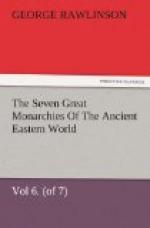Gotarzes, having triumphed over his rival, appears to have resolved on commemorating his victory in a novel manner. Instead of striking a new coin, like Vonones, he determined to place his achievement on record by making it the subject of a rock-tablet, which he caused to be engraved on the sacred mountain of Baghistan, adorned already with sculptures and inscriptions by the greatest of the Achaemenian monarchs. The bas-relief and its inscription have been much damaged, both by the waste of ages and the rude hand of man; but enough remains to show that the conqueror was represented as pursuing his enemies in the field, on horseback, while a winged Victory, flying in the air, was on the point of placing a diadem on his head. In the Greek legend which accompanied the sculpture he was termed “Satrap of Satraps”—an equivalent of the ordinary title “King of Kings”; and his conquered rival was mentioned under the name of Mithrates, a corrupt form of the more common or Mithridates or Meherdates.
Very shortly after his victory Gotarzes died. His last year seems to have been A.D. 51. According to Tacitus, he died a natural death, from the effects of disease; but, according to Josephus, he was the victim of a conspiracy. The authority of Tacitus, here as elsewhere generally, is to be preferred; and we may regard Gotarzes as ending peacefully his unquiet reign, which had begun in A.D. 42, immediately after the death of his father, had been interrupted for four years—from A.D. 42 to A.D. 46—and had then been renewed and lasted from A.D. 46 to A.D. 51. Gotarzes was not a prince of any remarkable talents, or of a character differing in any important respects from the ordinary Parthian type. He was perhaps even more cruel than the bulk of the Arsacidae, though his treatment of Meherdates showed that he could be lenient upon occasion. He was more prudent than daring, more politic than brave, more bent on maintaining his own position than on advancing the power or dignity of his country. Parthia owed little or nothing to him. The internal organization of the country must have suffered from his long wars with his brother and his nephew; its external reputation was not increased by one whose foreign expeditions were uniformly unfortunate.




